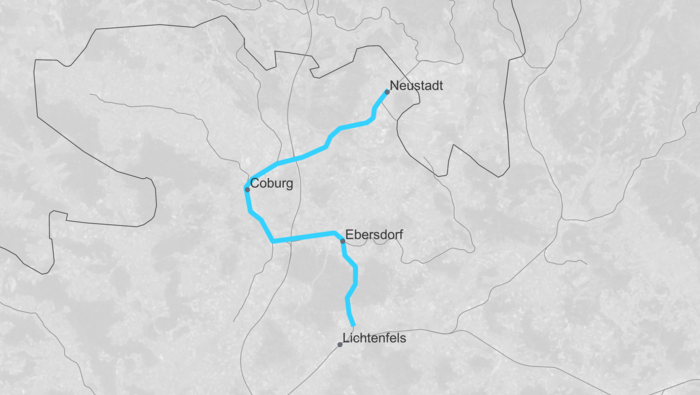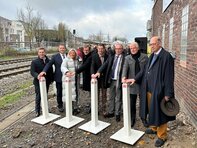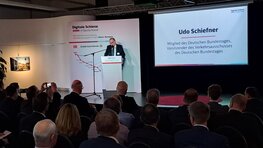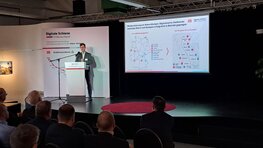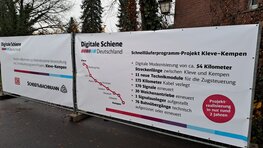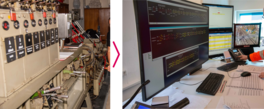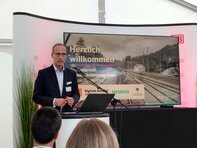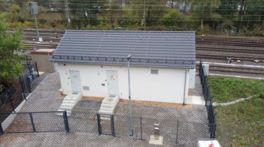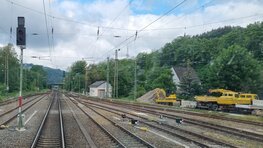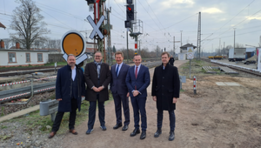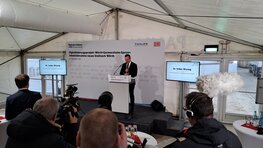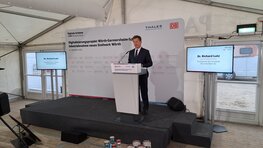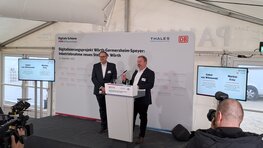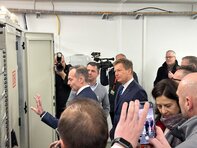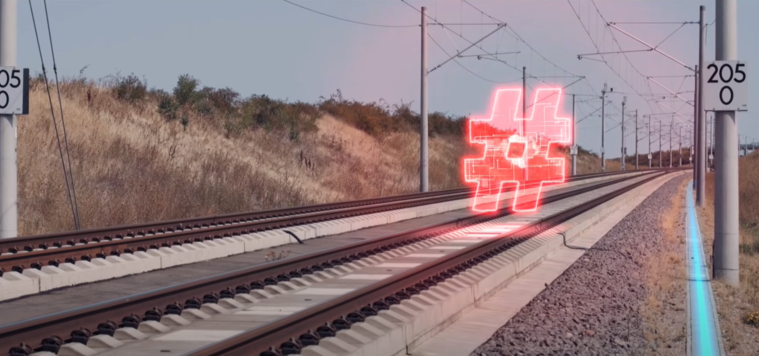
Fast-Track Programme
More reliability and less maintenance thanks to modern signalling, interlocking and level crossing technology. First commissioning around 1.5 years after construction begins in 2022. Collection of findings for the rollout of Digitale Schiene Deutschland (DSD). This is the Fast-Track Programme.
Fast-Track Programme (SLP)
The name says it all. The Fast-Track Programme (SLP: Schnellläuferprogramm) was launched on the initiative of the federal government, the rail industry and Deutsche Bahn (DB). It is an economic stimulus programme to combat the consequences of the coronavirus pandemic in order to secure jobs and strengthen the industry. The federal government is providing additional funding of EUR 500 million for the years 2020 - 2022, EUR 100 million of which is already available in 2020. Within a very short period of time, the existing signalling, interlocking and level crossing technology will be replaced by modern and digital interlocking elements in a total of seven projects. Normally, much longer periods of time are required for comparable projects. Processes are being improved and standards established in close cooperation with the industry in order to significantly speed up project execution. This is an important building block for the digitalisation of the rail network as part of Digitale Schiene Deutschland (DSD).
The agreement signed on September 2, 2020 between the above-mentioned parties to accelerate the equipment of the rail network with digital control and safety technology (DLST: Digitale Leit- und Sicherungstechnik) in the DSD rollout. Germany will thus benefit from a digital and future-oriented rail network several years earlier than originally planned. This enables the achievement of transport and climate policy goals and strengthens Germany as a business location.
However, ambitious goals require new approaches with high efficiency and short implementation times, which are being developed and tested in the Fast-Track Programme. Lean processes and new standards essentially form the foundation of the acceleration. As a result, valuable insights are gained for the DSD rollout. The approach is unique.

„
With the Fast-Track Programme, the federal government, the rail industry and DB are essentially pursuing two goals: Firstly, to secure employment in the industry with an economic impact and to strengthen it. Secondly, to gather valuable insights for the rollout of Digitale Schiene Deutschland."
Frank Gülicher, DB AG Representative for BIM Infrastructure and Head of DSD Project Portfolio (Digitale Schiene Deutschland, DB InfraGO AG)
SLP projects
In order to be able to start the SLP at short notice and at high speed, the seven projects were selected according to the parameters of comparatively low complexity and low impact on ongoing operations and other construction projects. The projects are divided into two clusters: the four projects in Cluster 1 are the responsibility of signaling technology manufacturers established on the German market. In these projects, electronic interlockings (ESTW: Elektronische Stellwerke) with digital interlocking elements and standardised interfaces are being built.
The three projects in Cluster 2 are the responsibility of signaling technology manufacturers not yet established on the German market. As part of the Fast-Track Programme, these manufacturers will be given the opportunity to implement digital interlocking technology in accordance with DB's specifications and obtain approval. The aim is to expand the market through the entry of new signaling companies in order to be able to draw on a higher capacity and broader expertise for the DSD rollout. Digital interlockings (DSTW: Digitale Stellwerke) are being built in the Cluster 2 projects. The first step will involve development work from 2021, so that the first construction work can follow from 2022. According to the current planning status, commissioning is scheduled for 2024 and 2025.
In addition to the modernisation of the interlocking technology, around 1.600 km of cable will be laid in all seven projects, around 1.000 signals, approx. 350 point machines, around 190 level crossings and approx. 16 signal booms will be renewed.
In technical terms, this is a so-called 1:1 replacement of the previous signalling, interlocking and level crossing technology with new and modern interlocking elements that will be upwardly compatible with later DSD target images. The following defined and standardised interfaces will be implemented regardless of the manufacturer: SCI-LX (interlocking - level crossing), SCI-ILS (interlocking - interlocking), SCI-CC (interlocking - operating system) and SCI-RBC (interlocking - Radio Block Center). This technology is intended to increase the reliability of the rail network and reduce maintenance costs. The aim is to make the rail network more robust. The manufacturer-independent interfaces also enable a sustainable reduction in the diversity of technology. In the individual projects, greater flexibility is also achieved through, for example, Ks signal systems or integrated train control. In some cases, track-change operation is being retrofitted with the benefits of time savings at construction sites with single-track operation. The lines are thus being made fit for the digital age.
Route map
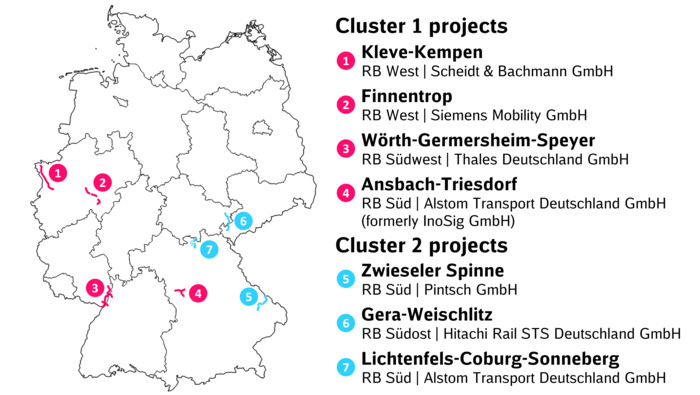
Technologies and timetable
Film off for the Fast-Track Programme (in German only)
Contact
Disclaimer
The dates shown are legally non-binding forecasts based on the current status. The forecasts are in no way intended to establish any kind of legal claim whatsoever that completion will take place by the specified date and that use will be possible. For these reasons, the information should also not be used to make or prepare business decisions, for example, but not conclusively, with regard to the vehicle equipment or the compatibility between the vehicles and the infrastructure. If you have any questions, particularly regarding technical network access or obtaining binding information, please contact your customer advisor.
Most of the infrastructure projects are still in the planning phase, which means that the information provided on these pages reflects the current planning status and is updated regularly.

Kleve-Kempen
Kleve-Kempen is the SLP's first Cluster 1 project. In less than two years, the interlockings in Kleve, Bedburg - Hau, Goch, Weeze, Kevelaer, Geldern, Vernum, Nieukerk, Aldekerk and Kempen were replaced with modern electronic interlocking technology on the left bank of the Lower Rhine between Kleve and Kempen. Scheidt & Bachmann GmbH installed a total of eleven electronic interlockings (type ZSB 2000) on the approximately 54 kilometers of track, which are now operated from the six interlockings in Kleve, Bedburg - Hau, Goch, Kevelaer, Nieukerk and Kempen. These have been technically upgraded accordingly. As a technical innovation, the iLBS has been set up with a local network. In addition, track-change operation was implemented in the double-track section and increasing number of signal blocks was implemented. The first section of the Kleve-Geldern line was commissioned on December 4, 2021, followed by the complete commissioning at the end of November 2022.
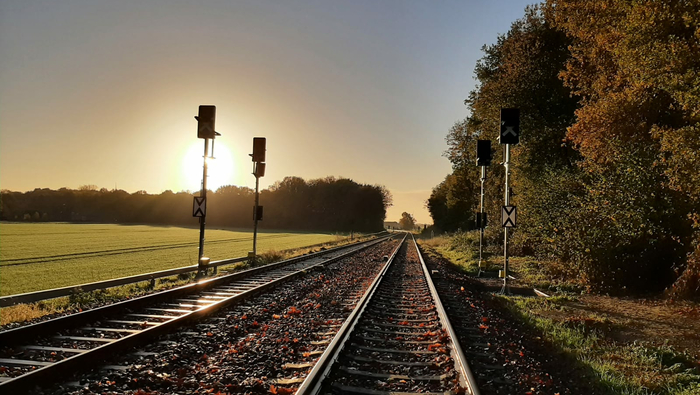
Project duration
Route data
| Line from | Kleve |
|---|---|
| Line to | Kempen |
| Kilometers of line to be equipped | 54 km |
| Route number(s) | 2610 |
Planned actions
| ETCS | - |
|---|---|
| Interlocking(s) | 11 ESTW-A |
| Scope of equipment |
|
Route map
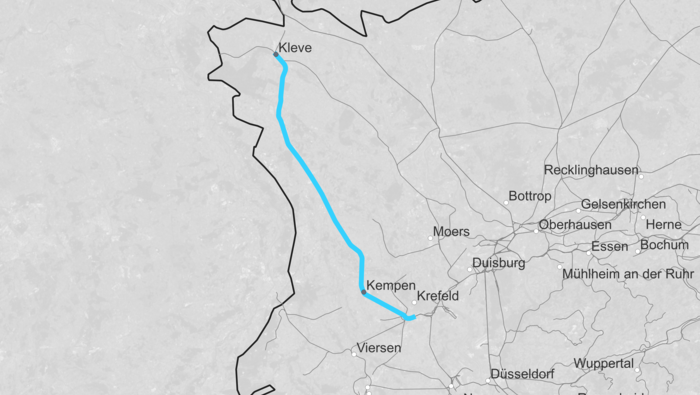
Technologies
Installation of a technology module in Bedburg-Hau
Fast-Track Programme: Installation of the Bedburg-Hau technology module as part of the SLP-project Kleve-Kempen.
Cab ride between Kleve and Kempen
Fast-Track Programme: Cab ride on the route of the SLP-project Kleve-Kempen.
- Press release: Start of construction (in German only) (11/05/2021)
- Press release: Construction site visit by Ronald Pofalla and Hendrik Wüst (in German only) (06/07/2021)
- Press release: Construction work 1st construction phase (in German only) (30/07/2021)
- Press release: Construction work 2nd construction phase (in German only) (31/05/2022)
- Press release: Successful commissioning (in German only) (06/12/2022)
Finnentrop
Finnentrop is one of the SLP's Cluster 1 projects and was successfully commissioned after around one and a half years. This is the first complete commissioning in the SLP. The modernisation was carried out on the Ruhr-Sieg line on the three sections 1) Letmathe-Nachrodt-Altena-Werdohl, 2) Werdohl-Plettenberg-Finnentrop and 3) Grevenbrück-Lennestadt-Meggen, -Altenhundem, -Kirchhundem-Welschen-Ennest. The three interlockings in Altenhundem/Meggen, Plettenberg and Nachrodt/Altena, which were between 30 and 50 years old, were replaced with modern Simis-D interlocking technology from Siemens Mobility GmbH. The interlockings were connected to the existing central electronic interlocking in Finnentrop, which was technically upgraded. Since commissioning in May 2022, the line from Letmathe to Kreuztal has been operated centrally by the signallers from Finnentrop.
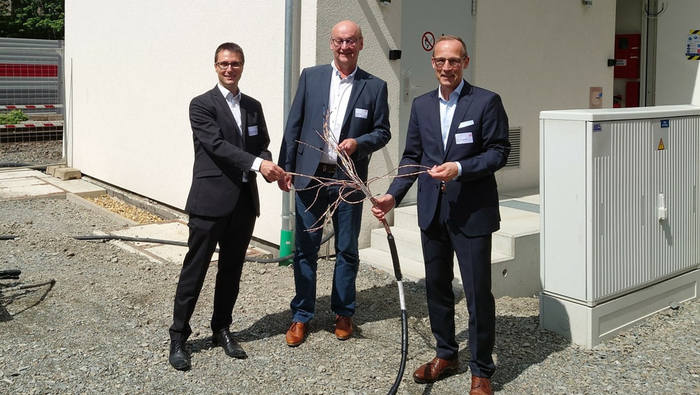
Project duration
Route data
| Line from | Letmathe |
|---|---|
| Line to | Welschen-Ennest |
| Kilometers of line to be equipped | 45 km |
| Route number(s) | 2800 |
Planned actions
| ETCS | - |
|---|---|
| Interlocking(s) | 1 ESTW-Z, 3 ESTW-A |
| Scope of equipment |
|
Route map
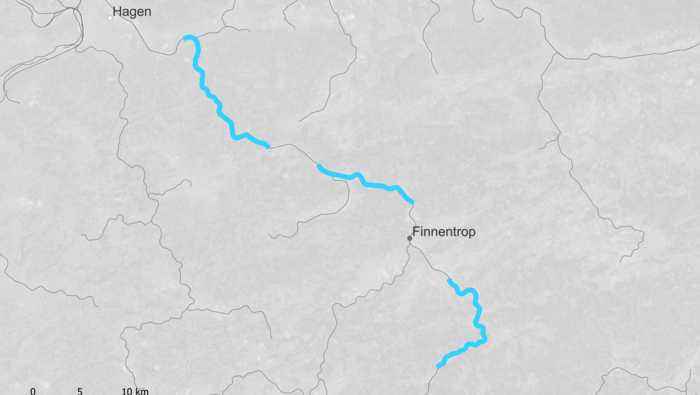
Wörth-Germersheim-Speyer
The Wörth-Germersheim-Speyer line is a Cluster 1 project and was successfully put into operation in 2022. The seven old interlockings in Speyer, Germersheim, Wörth, Philippsburg and Rülzheim on the line between the towns of Wörth, Germersheim and Speyer were replaced by modern ESTW L90 interlocking technology from Thales Deutschland GmbH. This replaced the largest mechanical interlocking still in operation in Germany - the interlocking in Wörth am Rhein. Here, too, the line is now operated by mouse click instead of with levers. To this end, modern technical modules (ESTW-A) were installed in the Philippsburg, Speyer, Wörth and Rülzheim stations. They are operated via the new central electronic interlocking in Germersheim. Between Speyer and Germersheim as well as between Germersheim and Wörth, a track-change operation including increasing number of signal blocks was set up, which enables an improvement in operating quality. Commissioning took place in three stages in 2022.
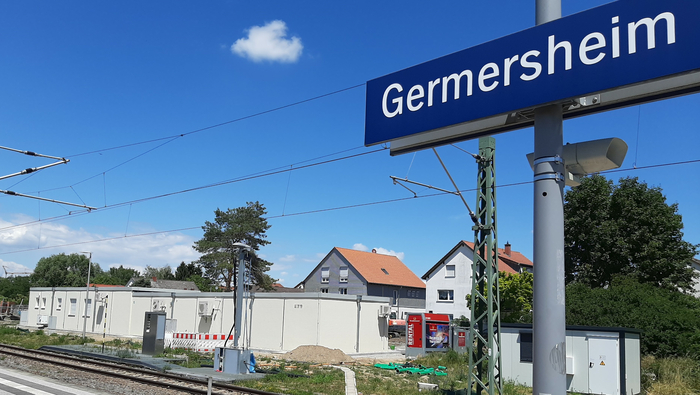
Project duration
Route data
| Line from | Speyer |
|---|---|
| Line to | Wörth |
| Kilometers of line to be equipped | 41 km |
| Route number(s) | 3400, 3443, 3450, 4132 |
Planned actions
| ETCS | - |
|---|---|
| Interlocking(s) | 1 ESTW-Z, 4 ESTW-A |
| Ausrüstungsumfang |
|
Route map
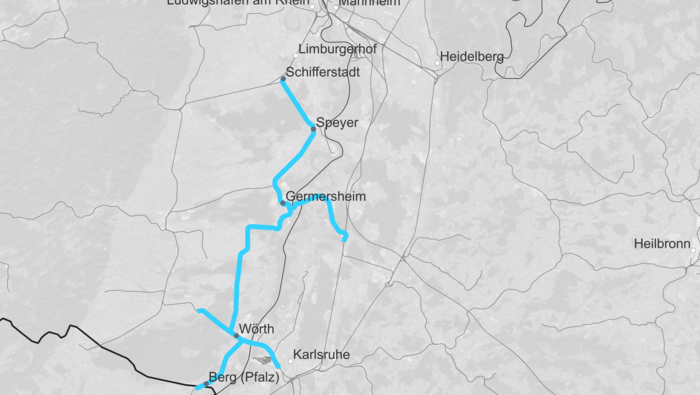
Technologies
- Press release: Start of construction (in German only) (16/04/2021)
- Press release: Commissioning of 1st construction phase (in German only) (24/06/2022)
- Press release: Construction work 2nd construction phase (in German only) (25/07/2022)
- Press release: Successful commissioning (in German only) (12/12/2022)
Ansbach-Triesdorf
Ansbach-Triesdorf is the fourth Cluster 1 project. The two lines Ansbach-Triesdorf and Leutershausen-Wiedersbach-Ansbach-Wicklesgreuth are part of the project. The company Alstom Transport Deutschland GmbH (formerly InoSig GmbH) is replacing the approximately 55-year-old interlockings at Ansbach and Triesdorf stations with modern B950 electronic interlockings. The new central interlocking with an integrated control station is being built in Ansbach, from which the signallers will also control the new technical module in Triesdorf electronically from spring 2025.
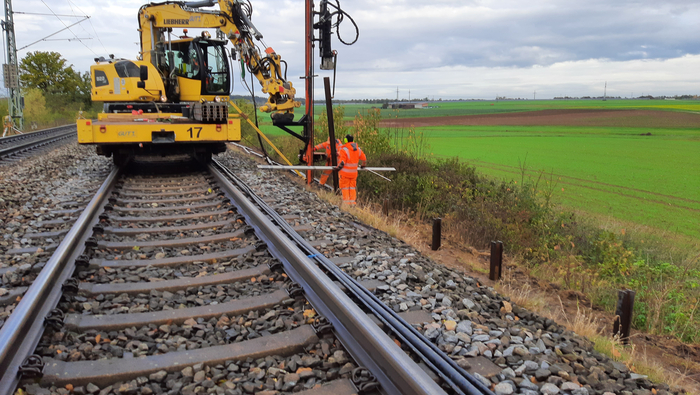
Project duration
Route data
| Line from | Ansbach |
|---|---|
| Line to | Triesdorf |
| Kilometers of line to be equipped | 44 km |
| Route number(s) | 5321, 5902 |
Planned actions
| ETCS | - |
|---|---|
| Interlocking(s) | 1 ESTW-Z, 1 ESTW-A |
| Scope of equipment |
|
Route map
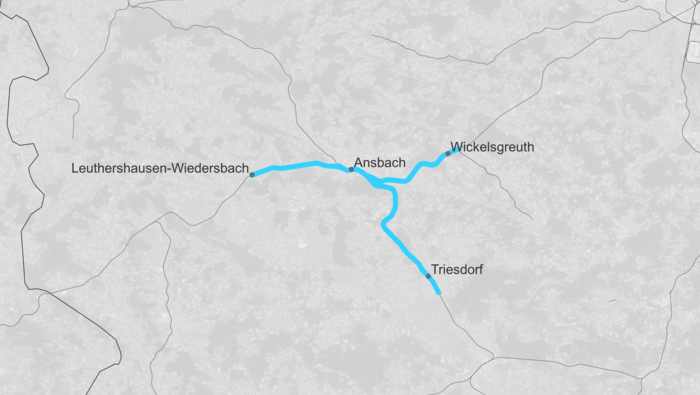
Technologies
Zwieseler Spinne
The Cluster 2 project Zwieseler Spinne is digitising the lines around Zwiesel in the Bavarian Forest with modern signalling, interlocking and level crossing technology. The company Pintsch GmbH is replacing the six interlockings in Grafling, Gotteszell, Triefenried, Bayerisch Eisenstein and Zwiesel with PinMovio digital interlocking technology. In future, they will be operated from the central digital interlocking (DSTW-ZE) in Zwiesel. The five technical modules (so-called track field concentrators: GFK) are located in Zwiesel, Grafling, Gotteszell, Triefenried and Bayerisch Eisenstein.
After extensive development work, construction began on July 25, 2022 and commissioning is scheduled for December 2024.
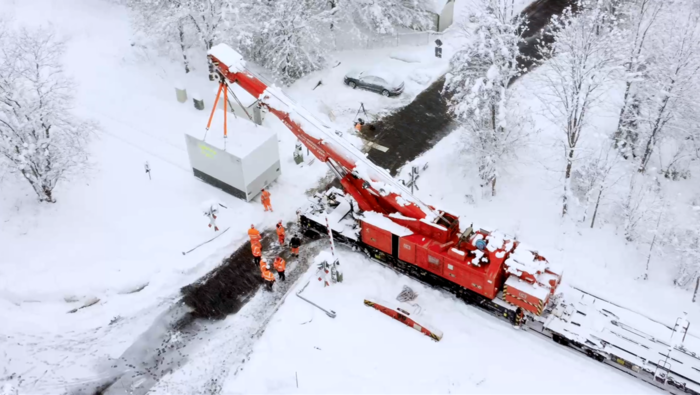
Project duration
Route data
| Line from | Bavarian Eisenstein |
|---|---|
| Line to | Grafling |
| Kilometers of line to be equipped | 76 km |
| Route number(s) | 5634, 5820 |
Planned actions
| ETCS | - |
|---|---|
| Interlocking(s) | 1 DSTW-ZE incl. GFK, 4 additional GFK |
| Scope of equipment |
|
Route map
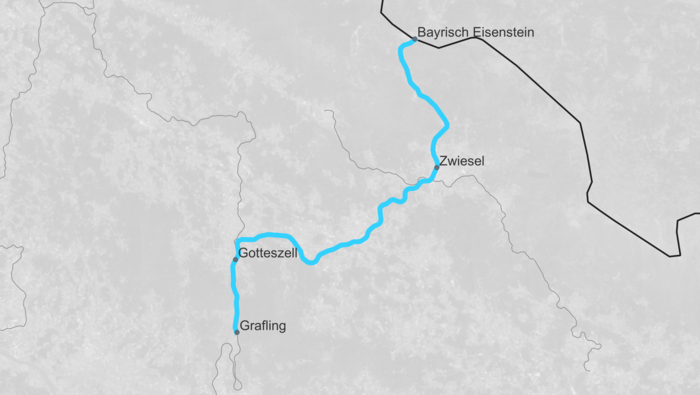
Media library and links
Special winter operation for emergency crane
Fast-Track Programme: Installation of three technical modules (so-called track field concentrators) in adverse weather conditions. An impressive endeavour that not only required the use of an emergency crane, but also the active support and goal-oriented cooperation of everyone involved.
Gera-Weischlitz
Gera-Weischlitz is one of the Cluster 2 projects. On the line between Gera and Weischlitz, Hitachi Rail STS Deutschland GmbH is renewing a total of twelve interlockings in Wünschendorf (Elster), Berga (Elster), Greiz, Greiz-Dölau, Elsterberg, Barthmühle and Plauen (Vogtl.) lower station. A digital interlocking in Plauen and seven technical modules (so-called track field concentrators) will be built at these locations. Commissioning is scheduled for December 2025. From this date, the line will be operated from Plauen (Vogtl.) lower station using the new, integrated control and operating system (iLBS: integriertes Leit- und Bediensystem).
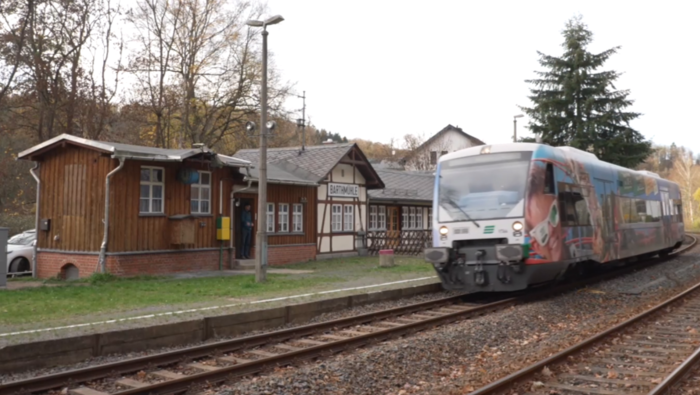
Project duration
Route data
| Line from | Gera |
|---|---|
| Line to | Weischlitz |
| Kilometers of line to be equipped | 52 km |
| Route numbers | 6269 |
Planned actions
| ETCS | - |
|---|---|
| Interlocking(s) | 1 DSTW-ZE, 7 GFK |
| Scope of equipment |
|
Route map
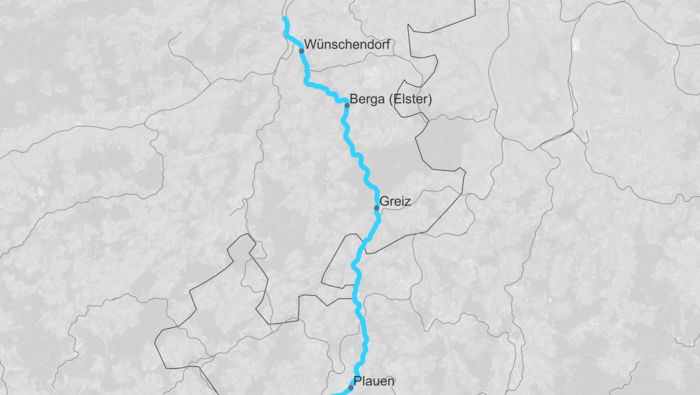
Lichtenfels-Coburg-Sonneberg
Lichtenfels-Coburg-Sonneberg is the third Cluster 2 project that runs through Thuringia and Bavaria. The existing nine interlockings in Neustadt/Coburg, Rödental, Ebersdorf/Coburg, Seehof, Coburg, Herzogsweg and Creidlitz will be renewed on the approximately 45 km long line between Lichtenfels, Coburg and Sonneberg. To this end, Alstom Transport Deutschland GmbH is building a central digital interlocking in Coburg as well as five electronic technical modules in Neustadt/Coburg, Ebersdorf/Coburg, Herzogsweg, Coburg and Creidlitz. The line will continue to be operated from Coburg. Commissioning is scheduled for December 2024.
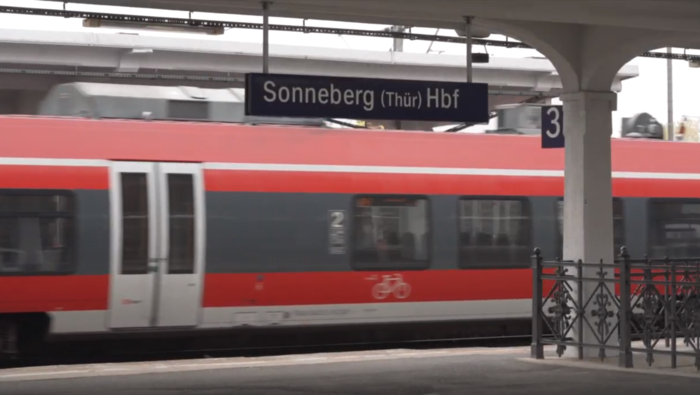
Project duration
Route data
| Line from | Lichtenfels |
|---|---|
| Line to | Sonneberg |
| Kilometers of line to be equipped | 45 km |
| Route numbers | 5121, 6311 |
Planned actions
| ETCS | - |
|---|---|
| Interlocking(s) | 1 DSTW-Z, 5 ESTW-D |
| Scope of equipment |
|
Route map
